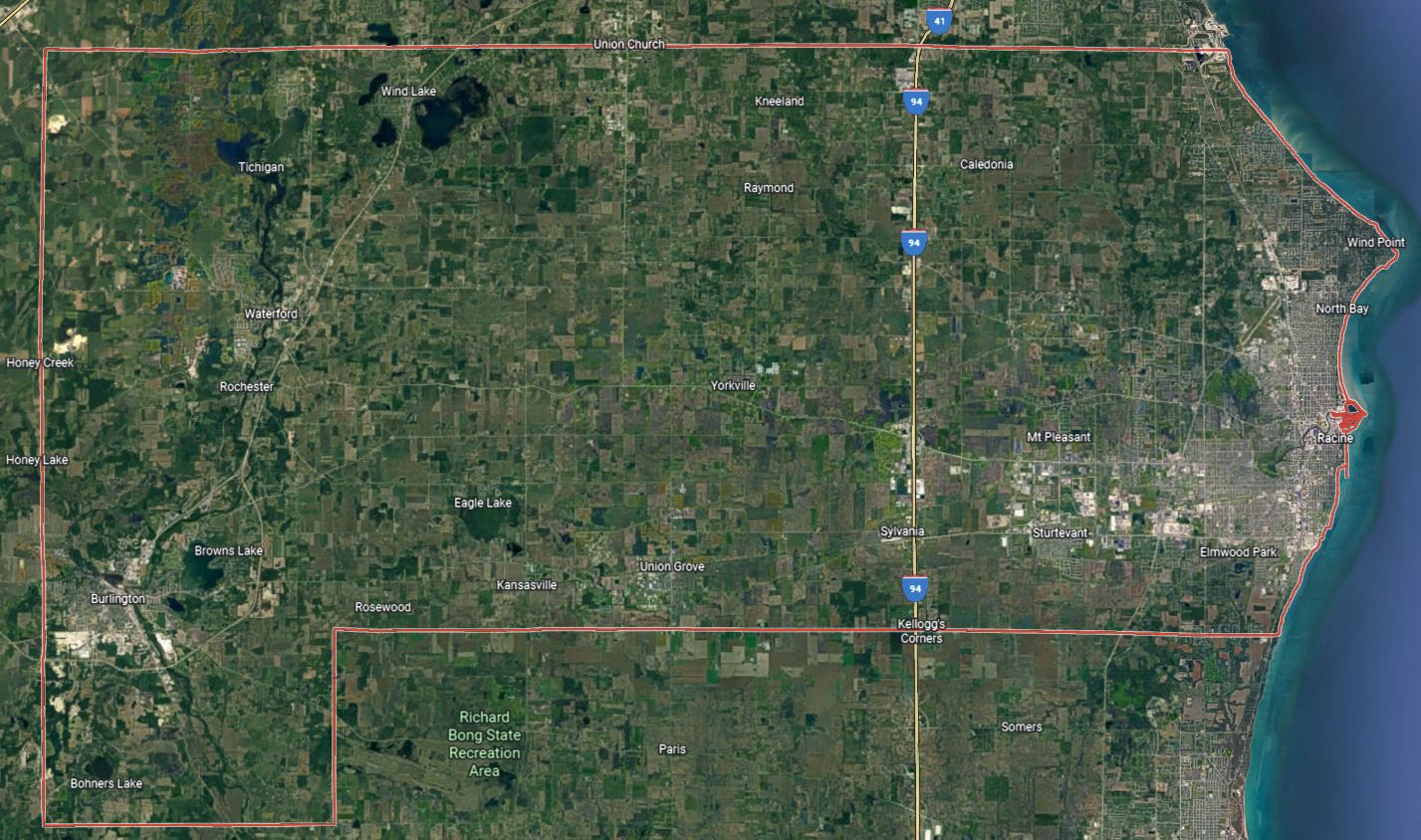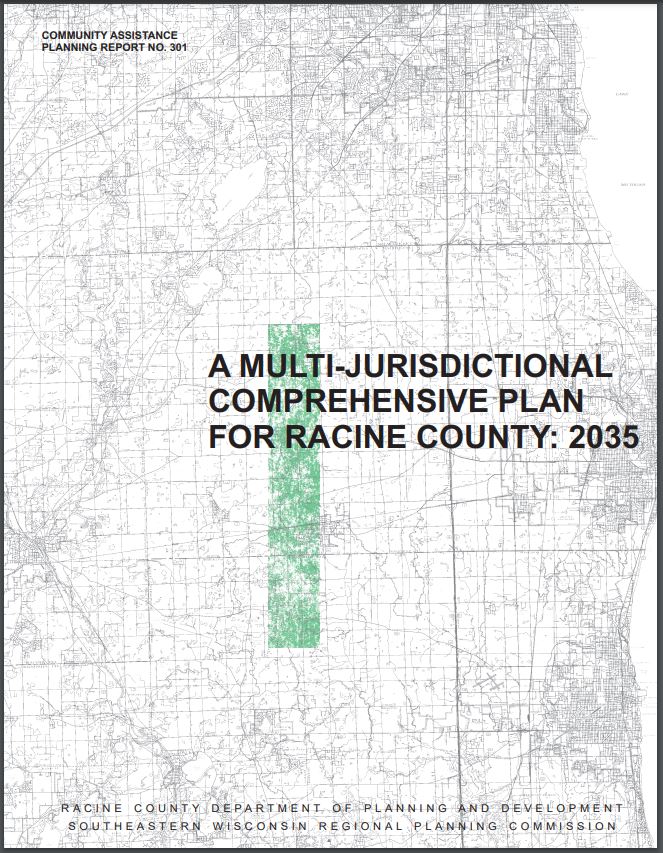
There was a need to address new comprehensive planning requirements and to reduce planning costs across the County.
Racine County Multi-Jurisdictional Comprehensive Plan
Overview
Title of Project: Racine County Multi-Jurisdictional Comprehensive Plan
Organization(s): Racine County & Southeastern Wisconsin Regional Planning Commission
Project Cost: $639,000
Grant Award(s): Wisconsin Department of Administration Comprehensive Planning Grant
Collaborators:
- Racine County Public Works and Development Department
- Southeastern Wisconsin Regional Planning Commission (SEWRPC)
- UW-Extension
- Racine County Municipalities:
- City of Burlington
- City of Racine
- Village of Caledonia
- Village of Elmwood Park
- Village of Mount Pleasant
- Village of North Bay
- Village of Rochester*
- Village of Sturtevant
- Village of Union Grove
- Village of Waterford
- Village of Windpoint
- Town of Burlington
- Town of Dover
- Town of Norway
- Town of Raymond
- Town of Waterford
- Town of Yorkville
*The Village and Town of Rochester merged in December 2008
The Coastal Resilience Issue
Racine County has four coastal municipalities with approximately 14.8 miles of Lake Michigan coastline. These communities face coastal hazards including erosion, changing water levels, coastal storms, and flooding. Coastal erosion and bluff stability are important aspects of planning for the protection, development, and/or redevelopment of land located along Lake Michigan.

Racine County, Wisconsin. Image from Google Earth.
Vision for the Community
Racine County wants to promote responsible land use and growth and encourage development that supports community and economic growth.
The Need
In 1999, the Wisconsin Legislature enacted a new comprehensive planning law which would take effect on January 1, 2010. The comprehensive planning law required the County plan and each local plan to be consistent with each other and include the following nine elements:
- Issues and Opportunities
- Land Use
- Agricultural, Natural, and Cultural Resources
- Housing
- Transportation
- Utilities and Community Facilities
- Economic Development
- Implementation
- Intergovernmental Cooperation
A cooperative, comprehensive planning process was undertaken by Racine County, SEWRPC, and Racine County’s 17 municipalities to address the new comprehensive planning requirements and to reduce planning costs across the County. A multi-jurisdictional comprehensive plan would create a single-source reference document for each of the municipalities’ asset inventories and land-use plans.
The Process

In 2005, the County was awarded a $639,000 Comprehensive Planning Grant from the Wisconsin Department of Administration. Planning work began in 2006.
Prior to securing funding, Racine County conducted outreach to each of the County’s 17 municipalities. The County had 100% participation from its municipalities in the multi-jurisdictional planning process.
The project was advised by the Racine County Multi-Jurisdictional Advisory Committee which was made up of one representative from each participating municipality. The committee met monthly with County officials to develop the comprehensive plan.
SEWRPC led the planning process. Their process consists of seven steps including: 1) identify participating local governments and the execute planning agreements; 2) inventory and collect basic data required for the plan; 3) prepare projections of future population and employment levels; 4) identify issues and develop goals and objectives; 5) prepare the plan elements; 6) identify plan implementation measures; and 7) review, refine, and adopt the comprehensive plan.
The inventories were conducted by SEWRPC and shared with the municipalities. Any existing, local land use plans and master plans were incorporated into the County comprehensive plan. Regular meetings were held with individual communities as well as the whole group to review chapters of the plan as they became available. At these meetings, municipalities were engaged to present their own ideas and lead local decisions as they related to their community’s goals and objectives.
Stabilizing the shoreline and protecting coastal infrastructure is a large investment for Racine County and its municipalities. The incorporation of Lake Michigan shoreline erosion protection and preservation in this plan was driven by the 2005 study of Racine County’s coastline by Dr. Scudder Mackey. This study helped form the recommendations in their Agricultural, Natural, and Cultural Resources Plan to ensure the responsible development of the shoreline and protection of shoreline stability.
Public input was sought about each of the nine key elements. UW-Extension assisted with the public participation element including distribution of surveys and mailings. Public meetings and hearings were also held throughout this process.
What Has Been Accomplished So Far
This process took three years and the plan was completed and adopted in 2009. All of Racine County’s 17 municipalities adopted the multi-jurisdictional comprehensive plan. This plan is regularly used to guide the protection, development, and/or redevelopment of land located along Lake Michigan as well as the land in the rest of the County.
The full, multi-jurisdictional plan for Racine County can be found here.
Partnerships
The success of this project was underpinned by the relationships between Racine County’s municipalities. Elected officials entered the process as partners. In a multi-jurisdictional approach, there are overlapping areas of interest; however, the municipalities worked together to shape the comprehensive plan. All communities endorsed preserving Lake Michigan’s environmental corridors. Where there were differences in planning goals for areas of shared interest throughout the County, they utilized boundary agreements.
While the comprehensive plan was being compiled as a county plan, it was ensured that the comprehensive plan itself was an aggregation of the individual municipalities’ local plans.
Going Forward
The Racine County Multi-Jurisdictional Comprehensive Plan will need to be updated in the next several years. Some municipalities have updated their local plans which would be incorporated into the updated multi-jurisdictional plan if they choose to participate again. Racine County is currently working to secure funding for the next update. It is estimated the process could take approximately 12 months.
Lessons Learned
- Allow for plenty of time before the plan is due to undergo the planning process
- Take the time to create buy-in from municipalities
- Build relationships between County staff and municipalities
- Utilize a multi-jurisdictional approach to save money and build capacity to develop a thorough plan that addresses all legal requirements
- Provide opportunities for public participation outside of typical 9-5 work days such as in the evenings or on the weekends
- Communicate early with municipalities about what procedural changes may occur after the adoption of the multi-jurisdictional plan




